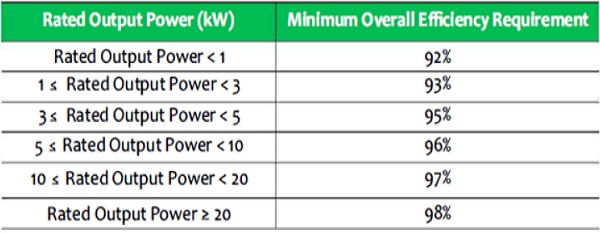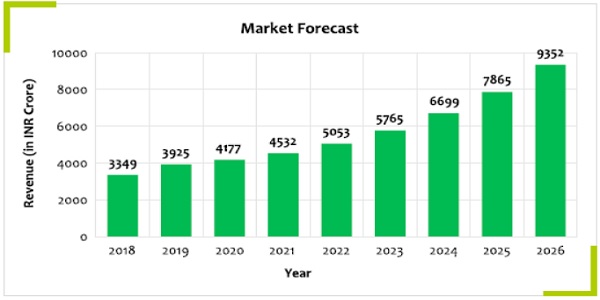Introduction: The Ministry of Power has launched a groundbreaking Standards and Labeling Program for Grid-Connected Solar Inverters, aimed at enhancing product quality, reducing emissions, and empowering consumers to make informed choices. This initiative, inaugurated by Union Power and New & Renewable Energy Minister R. K. Singh, marks a significant step towards achieving the nation’s sustainability goals.
Detailed Analysis:
1. Significance of Standards & Labeling Program: The newly launched program for Grid-Connected Solar Inverters is a crucial tool in reducing carbon dioxide emissions and ensuring high product quality. Union Minister R. K. Singh emphasized its role in enabling consumers to make informed choices aligned with the nation’s sustainability objectives.
2. Consumer Empowerment: By providing clear insights into product quality and efficiency, the program empowers consumers to invest wisely in reliable and durable solar solutions. It enables consumers to assess the overall efficiency and performance of inverters, thereby fostering a greener planet while saving energy and reducing electricity consumption.
3. Technical Specifications: The program sets Minimum Energy Performance Standards (MEPS) for grid-connected solar inverters, covering products up to 100 kW capacity. Only BIS-certified inverters complying with safety standards are eligible for participation, ensuring adherence to quality and safety norms.
4. Expected Impact: Implementation of the program is projected to save a significant amount of energy and reduce carbon dioxide emissions between 2024-25 and 2033-2034. It is estimated to contribute to substantial energy savings and emission reductions, further advancing India’s renewable energy goals.
Conclusion: The launch of the Standards and Labeling Program for Grid-Connected Solar Inverters by the Ministry of Power signifies a critical milestone in India’s journey towards sustainable energy and environmental conservation. By promoting product quality, transparency, and consumer empowerment, this initiative not only accelerates the adoption of renewable energy but also fosters a culture of sustainability and responsibility. As India continues to prioritize renewable energy solutions, such programs play a pivotal role in driving innovation, efficiency, and environmental stewardship in the power sector.
******
Ministry of Power
Standards and Labeling Program for Grid Connected Solar Inverter Launched; Union Power and New & Renewable Energy Minister hails Program, stating that it enables consumers to make informed choices which align with nation’s sustainability goals
Standards & Labelling Program is an important tool in reducing carbon dioxide emissions and in ensuring high product quality: Union Power and New & Renewable Energy Minister R. K. Singh
Program will help consumers in getting better-quality inverters which can be used as part of the solar rooftop system
S&L Program for Solar Inverters aims to further optimize efficiency of solar PV system, enabling consumers to assess overall efficiency and performance of inverters
S&L Program for Grid Connected Solar Inverter expected to save 21.1 billion kWh of energy and reduce 15.1 million tonnes of carbon dioxide emissions between 2024-25 and 2033-2034
The Bureau of Energy Efficiency under the Ministry of Power, Government of India has come out with one more Standards and Labeling Program, which aims to help consumers make informed choices considering cost-effectiveness and energy performance of various energy-consuming appliances, thus enabling them to save energy, reduce electricity consumption and also contribute to a greener planet. The latest product to be added to BEE’s Standards and Labeling Programs is the Grid-Connected Solar Inverter, with the launch of the Standards and Labeling Program for the solar inverter under voluntary phase, by the Union Power and New & Renewable Energy Minister Shri R. K. Singh in New Delhi today, March 15, 2024. The Program will help consumers in getting better-quality inverters which can be used as part of the solar rooftop system.
Union Power Secretary Shri Pankaj Agarwal; Secretary, New & Renewable Energy, Shri Bhupinder Singh Bhalla; Additional Secretary, Ministry of Power, Shri Ajay Tewari; Additional Secretary, Ministry of New & Renewable Energy, Shri Sudeep Jain; and Director General, BEE Shri Abhay Bakre were also present on the occasion.
“S&L Program is an important tool in reducing carbon dioxide emissions”
Speaking at the launch event, the Union Power and New & Renewable Energy Minister said that the S&L Programs of BEE have resulted in reduction in carbon dioxide emissions by 60 million tonnes per annum. “The S&L Program is an important tool in reducing carbon dioxide emissions. The other advantage is that we save money, given the quantum of energy saved. In this way, the Program benefits both the consumer as well as the system.” The Minister spoke also of the Perform Achieve Trade Scheme of BEE, which he said has resulted in reduction of about 110 million tonnes of carbon dioxide emissions per annum.
“S&L Program a way to ensure product quality, necessary for global competitiveness”
The Power and New & Renewable Energy Minister told the gathering that the S&L Program is a way for ensuring product quality, which is necessary for global competitiveness. “We cannot make in India for the world unless we ensure quality. The days are gone when people will accept some product just because it is made in India.”
“People have been found to be willing to pay a premium if the quality is good”
The Minister informed that people will be willing to pay a premium if the quality is good. “This is seen in action in our S&L Program. This is one of our motivations behind expanding the S&L Program to more and more products. This is the secret of making Indian products competitive across the world.”
“S&L Program for grid-connected solar inverters will further contribute to Rooftop Solar”
The Minister informed that the rooftop solar programme has got a huge fillip with PM-Surya Ghar: Muft Bijli Yojana, announced by the Prime Minister on February 13, 2024. Transmission and distribution losses have come down to zero and reduction in carbon emissions are huge, since energy consumed is renewable energy, said the Minister. The Minister hoped that the S&L Program for grid-connected solar inverters will contribute to this mission.
About Standards and Labeling Program for Grid-Connected Solar Inverter
The Standards and Labeling Program for Grid Connected Solar Inverter has been launched under voluntary phase, valid from 15th March, 2024 till 31st December, 2025.
The program will function as a Minimum Energy Performance Standard (MEPS) for the product, covering only grid-connected solar inverter without storage, with rated capacity up to 100 kW (in alignment with recent Quality Control Order for solar photovoltaic inverters, issued by the Ministry of New & Renewable Energy).
Only BIS-certified solar inverters complying with safety standard IS 16221-2:2015 would be eligible to take part in the program. The endorsement Label adopted is based on minimum overall efficiency criteria in accordance with IS 17980:2022 / IEC 62891:2020 as amended from time to time.

The launch of the S&L Program follows BEE’s launch of Standards & Labeling (S&L) Program for solar panels, in October 2023. The Program for solar inverters aims to further optimize the efficiency of the solar PV system, so that consumers are able to assess the overall efficiency and performance of the inverter before deciding to purchase or use it.
The implementation of the Program is anticipated to yield significant energy savings of 21.1 billion kWh between FY 2024-25 and FY 2033-2034, accompanied by a potential reduction in carbon dioxide emissions of around 15.1 million tonnes during this period.
The market size of all types of solar inverters was close to 2,520 MW in the year 2022-23. The grid connected solar inverter was found to dominate the market with 80% share of the total solar inverter market. It is expected that the solar inverter market will be Rs. 9,352 crores by the year 2026, growing at a projected CAGR of 14.4% during the period from 2020 to 2026.

As per BEE’s market assessment, it is revealed that nearly 63% market share of grid connected solar inverter is of the models with rated output power capacity ranging from 1 kW to 10 kW, 13% share of models are those belonging to the range 11 kW to 20 kW and 24% share of models are above 20 kW rated output capacity.
Solar Inverters are categorized based on system type, technology, rated output power and application. In terms of system type, solar inverter is categorized into Grid Connected, Off-Grid and Hybrid solar inverters.
A brief note on the S&L Program for Grid-Connected Solar Inverters can be found here and a more detailed brochure on the program can be found here.

“Empowers consumers to invest wisely in reliable, efficient and durable solar solutions”
Speaking about the Program, Power Secretary, Shri Pankaj Agarwal said that the Program empowers consumers to invest wisely in reliable, efficient and durable solar solutions, by offering them clear insights about products. “The S&L Program for grid-connected solar inverters is set to revolutionize India’s renewable energy sector. This initiative serves as a catalyst for India’s transition towards sustainable energy, underscoring our dedication to a cleaner, greener future.”
“A pivotal moment in the quest for transparency, quality and sustainability in the solar sector”
Director General, BEE, Shri Abhay Bakre said: “Introducing the S&L Program for grid-connected solar inverters marks a pivotal moment in our quest for transparency, quality, and sustainability in the solar sector. It signifies a bold stride forward in our dedication to a greener and more energy-efficient world. Through this initiative, we empower consumers while fast-tracking our journey towards a brighter and more sustainable future.” He said that the S&L Program is a win-win by also encouraging manufacturers to come up with better quality products.
Recently, on March 1, 2024, on the 22nd Foundation Day of BEE, the Union Minister for Power and New & Renewable Energy launched two other Standards and Labeling Programs of BEE, one for Packaged Boilers and the other for Commercial Beverage Coolers, also known as Visi Coolers. More details below.
About BEE
The mission of the Bureau is to assist in developing policies and strategies with a thrust on self-regulation and market principles, within the overall framework of the Energy Conservation Act, 2001. The Vision of Bureau of Energy Efficiency (BEE) is to improve Energy Intensity of Indian Economy thereby contributing towards sustainable development of country. Read more about BEE here.
***




